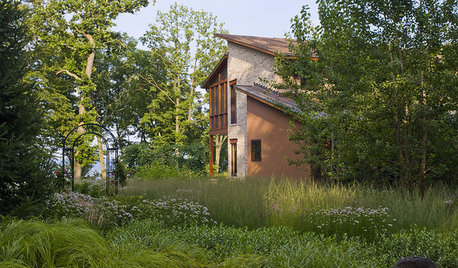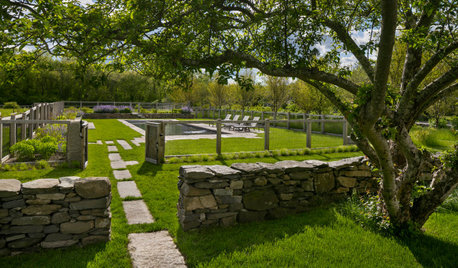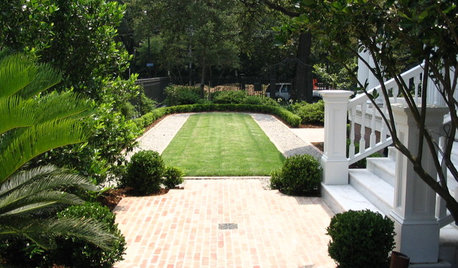looking for organic lawn care help in Wichita
falcon5105
8 years ago
Featured Answer
Sort by:Oldest
Comments (20)
falcon5105
8 years agoRelated Discussions
Looking for Organic Lawn Care Professional
Comments (1)They are very hard to find. State regulations are very strict in the lawn care industry. If a product is not specifically labeled for lawns, then licensed applicators are not allowed to apply it. For example, ordinary, unadulterated, soy bean meal is one of the best organic fertilizers there is. However it is illegal for a professionally licensed lawn care company to apply it unless it comes in a specially marked bag. A marked bag of soy might cost $60 for a 50-pound bag...or you could get it yourself from the feed store for $20. About all the pros can apply is compost and commercially bagged organic fertilizers. Most of them will not do it because of the pressure from their peers to stay with Lesco products. If you find a "pro" to do it, he is probably flying under the radar. I understand why the state has such rules. It keeps the real fly-by-night operators from selling a bag of organic sawdust and leaving town....See MoreHelp with organic lawn care
Comments (5)You might get more responses if you post in the Organic Lawncare Forum You can buy organic fertilizer, but a lot of organic lawns are fertilized with what would normally be considered animal feed, such as cracked corn, soybean meal, alfalfa, etc. I used to get coffee grounds from Starbucks and spread them (now I have native grasses and don't fertilize at all). I don't know anything about grubs, so I can't help there. The only organic pre-emergent that I know of is CGM. I've read mixed reviews of its effectiveness. From everything I've read, you need to make sure you use it correctly. I think it has to be watered in well and then it requires a dry spell because it works by drying the newly germinated grass before it can develop roots. If it rains at the wrong time, it won't work. Also, I've read that it takes a number of years for its effectiveness to start showing. You may get better results just through cultural practices. Mow at about 4 inches (or at the highest setting if the mower won't go that high). Water deeply and infrequently (shallow frequent water helps seeds germinate). Apply fertilizer in the spring and fall, with most of it in the fall. If you can get a dense grass cover, the crabgrass won't stand a chance....See MoreOrganic Lawn Care
Comments (20)I disagree. Compost is not fertilizer at all. It is depleted fertilizer. The stuff that went into making the compost was fertilizer back then, but now that it is finished compost, it has been fully decomposed. The fertilizer value, compared to real organic fertilizer, is nill. Back in the 1930s, J.I. Rodale proposed the idea that compost was the gold standard for organic gardening. That idea persisted until the 1990s when DNA testing on the soil revealed the true nature of soil. Prior to that testing, botanists had been able to grow about 12 different soil based fungi and bacteria in the laboratory. They figured there more than that actually in the soil and proposed that there would be as many as 50 different microbes. The first DNA testing revealed there were 30,000 to 35,000 different microbes. Subsequent testing in the 2000s revealed upwards of 100,000 different species of soil microbes. These are the guys which have been supporting life on the planet for billions of years. All of a sudden the teaching of Rodale was out the window. Feeding the microbes was found to be the solution to organic gardening. Compost has little to no food value left after the concentrated decomposition process. Instead the idea of feeding real food to the microbes came into vogue. The real food of choice is corn, wheat, soy, alfalfa, and other protein sources. These are usually available at your local feed store for $12 for a 50-pound bag and up. The application rate is 20 pounds per 1,000 square feet. It can be applied at double the rate with no harm. It can be applied at double the rate every week of the growing season with no harm. The cost per application is about $5 per 1,000 square feet. Compost, on the other hand, can cost up to $75 per 1,000 square feet depending on whether you need to have it delivered. Most people over apply compost bringing the cost to $150 per 1,000. When you apply that much compost to a lawn, it will smother it leaving a bigger mess than ever. Thus I disagree with the idea that compost is as good as anything. It is worse than almost anything and costs a small fortune....See MoreAny Organic gardener or lawn care experts needing Space?
Comments (2)Hello, We are looking for a small piece of land to use for growing an organic garden. We would like to either rent or work for trade....See Moret_d_harvey
8 years agofalcon5105
8 years agofalcon5105
8 years agodchall_san_antonio
8 years agofalcon5105
8 years agomorpheuspa (6B/7A, E. PA)
8 years agofalcon5105
8 years agodchall_san_antonio
8 years agodanielj_2009
8 years agofalcon5105
8 years agomorpheuspa (6B/7A, E. PA)
8 years agofalcon5105
8 years agolast modified: 8 years agot_d_harvey
8 years agodanielj_2009
8 years agomorpheuspa (6B/7A, E. PA)
8 years agofalcon5105
8 years agomorpheuspa (6B/7A, E. PA)
8 years ago
Related Stories

GARDENING GUIDES8 Unthirsty Plants Help You Save Water in Style
Spend less effort and money on your landscape with drought-tolerant and native plants that liven up your yard
Full Story
ORGANIZINGDo It for the Kids! A Few Routines Help a Home Run More Smoothly
Not a Naturally Organized person? These tips can help you tackle the onslaught of papers, meals, laundry — and even help you find your keys
Full Story
ORGANIZINGStick to Your Resolutions: Help From a Pro Organizer
Accomplish your goals — from decluttering to rediscovering fitness — for real this time
Full Story
ORGANIZING4 Questions to Help You Organize Your Favorite Photos
Organize your keeper photos with a system that's just right for you, whether it's in the cloud or you can hold it in your hand
Full Story
ORGANIZINGGet the Organizing Help You Need (Finally!)
Imagine having your closet whipped into shape by someone else. That’s the power of working with a pro
Full Story
STORAGEDownsizing Help: Shelve Your Storage Woes
Look to built-in, freestanding and hanging shelves for all the display and storage space you need in your smaller home
Full Story
GARDENING GUIDESHow to Keep Your Trees Healthy
Ensure your trees’ vigor for years to come with these tips for protecting roots, watering effectively and more
Full Story
COMMUNITYWant a Cleaner, Safer Neighborhood? Show You Care
Our behavior strongly influences others, says a new study. Show neighbors you care about your street and watch them follow suit
Full Story
GARDENING GUIDESTree Care: Common Tree Diseases and What to Do About Them
Learn to recognize trees that may be affected by diseases or pests so you can quickly take action
Full Story
GARDENING GUIDESHow to Plant a New Lawn From Sod
Take the quick-start route to turf with sod; these installation guidelines will help ensure a healthy and long-lasting lawn
Full Story




t_d_harvey